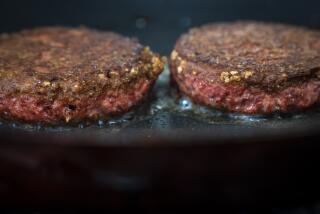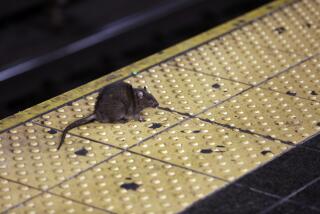For Some, Muskrat Love Warms Up Winter
- Share via
CAMBRIDGE, Md. — Got a taste for muskrat, a hankering for nutria, maybe a craving for raccoon? Then Roger Webster is your man.
The third-generation grocer and his family have been making a living since 1939 catering to customers in the Dorchester County seat who like things done the old-fashioned way.
And for many of Webster’s regulars, this is the time of year when the mounds of deli meats, hamburger, chops and chicken that fill his meat case just won’t do. The holidays are over, and the best way to get through a bleak Eastern Shore winter is to make a meal of the furry critters that frequent the marshes and woods in these parts.
Webster buys the meat from local trappers, who bring in the crimson carcasses after skinning the pelts, which are sold to fur buyers from Ohio, New Jersey and other states.
Last year, Webster sold about 1,500 muskrats, 70 or so raccoons and a handful of nutria, the oversized cousins of muskrats that were imported from Louisiana in the 1940s and whose eating habits are now blamed for wreaking havoc on Maryland marshes.
The trapping season has started, but so far, things don’t look good for muskrat lovers, Webster says.
“Right now, right this second, I’ve got muskrats. I don’t know about tomorrow,” says Webster, who quickly sold three dozen of the marsh creatures--his entire first shipment. It was delivered by Church Creek farmer Ralph Jackson on opening day of the trapping season, which runs from Jan. 1 through mid-March.
Webster and Jackson are two of what state officials say are a dwindling number of trappers and retailers still involved in the muskrat trade. “Now what you see is people trapping and selling the meat to friends, or friends of friends, people who’ve got a taste for it,” Jackson says.
The state doesn’t keep count of how many muskrats are taken each year, and no special permit beyond a standard hunting license is required to trap them. But many say that even if the brown-and-black rodents are as plentiful in the wild as ever, far fewer of them are making their way to the retail market.
Eugene “Wick” Lowe, who runs a seafood business near the Nanticoke River in Sharptown, blames the decline on the younger generation of farmers, watermen and outdoorsmen, who he says just aren’t willing to do the hard work of trapping for the $1.25 to $1.50 they can get per pelt or the $3 they might be paid for the meat of a big muskrat.
Lowe buys from local trappers when he can, but he says most of the 4,500 rodents he bought wholesale last year came frozen from an Ohio-based fur company.
“The younger generation just isn’t going to get out and walk through the marsh, get stuck in the mud, get their feet wet in icy water,” says Lowe, 72, who supplies the meat for several traditional muskrat dinner fund-raisers held by local volunteer fire companies every winter.
Maryland officials estimate that perhaps 2,000 to 3,000 people in the state are still involved in the muskrat trade. They believe that’s far fewer than in the past.
“The muskrats aren’t necessarily in short supply, but they’re trapped primarily for fur, and the bottom fell out of the fur market a few years ago,” says John Surrick, a spokesman for the Department of Natural Resources.
Webster’s customers prefer the first-name personal service at the 100-year-old grocery--the oldest in Cambridge--where they can run a tab until payday or have their orders delivered if they can’t get out. And many have come to expect muskrat meat, along with staples such as milk and bread.
For muskrat lovers--and the squeamish aren’t usually among them--folks generally divide along two lines: those who cook their muskrats whole, including the head and the rodents’ trademark front teeth, and those who can’t stand that idea.
“I haven’t eaten one in a long time, but muskrats are good-tasting,” says Adriana Walls, who lives three blocks from Webster’s and stops in almost daily. “I used to parboil them, then bake them with a mess of onions. I could never cook them with the heads, not with their blank eyes and their buck teeth looking at me.”
For Charles Streeter, who has shopped at Webster’s for better than 30 years, it just wouldn’t seem like winter without a few muskrat dinners.
“I draw the line at raccoons, though,” 72-year-old Streeter says. “Muskrats is good eating, but I’ve never tried coon meat.”
Chris Guy is a reporter for the Baltimore Sun, a Tribune company.
More to Read
Sign up for The Wild
We’ll help you find the best places to hike, bike and run, as well as the perfect silent spots for meditation and yoga.
You may occasionally receive promotional content from the Los Angeles Times.





